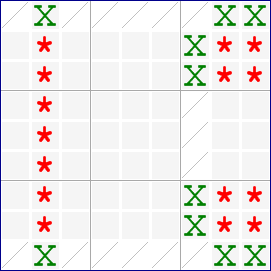Mirrored from Sudopedia, the Free Sudoku Reference Guide
Mutant Fish
When fish are no longer restricted to rows and columns, strange varieties emerge. When either the defining set or the secondary set contains a mixture of rows, columns and/or boxes, these fish are classified as mutant fish.
There are no mutant X-Wings, because the interaction between a single box and line is fully covered by the Locked Candidates technique.
Here is a fish diagram of a Mutant Swordfish, with the defining set consisting of 2 rows and 1 column, and the secondary set containing 1 column and 2 boxes.

Mutant fish can also be found in finned variations.
The 5 Mutant swordfish patterns
The previous example is the maximum pattern for the mutant swordfish. It consists of 10 cells with 3 group conjugates in rows 1 and 9 and column 7. Fortunately, 4 of the 10 cells in the maximum pattern are redundant. If a candidate is removed from a single cell of any or all of the 4 row and column groups in box 3 and 9, the pattern will still work. Therefore there are 5 patterns for the mutant swordfish with 6, 7, 8, 9, and 10 cells. This is analogous to the 4 patterns of the row or column swordfish with 6, 7. 8. or 9 cells. The maximum pattern is by far the rarest of the 5 patterns.
Minimum Pattern for the Mutant Swordfish
The minimum mutant swordfish pattern, which contains only 6 cells is shown in the diagram below. Here all of the group conjugates in the previous example become conjugate pairs.
How it works
There are 3 sets of conjugate pairs in the pattern, AC, BD, and EF. For each of these, one cell must be X and the other must be not X. If A is X, its conjugate C must be not X and there can be no other X in column 2 including B. Therefore B's Conjugate D must be X and and there can be no other X in box 9 including F. Therefore F's conjugate E must be X and there can be no other X in box 3. If B is X, its conjugate D must be not X and there can be no other X in column 2 including A. Therefore A's Conjugate C must be X and and there can be no other X in box 3 including E. Therefore E's conjugate F must be X and there can be no other X in box 9.
A Finned Mutant Swordfish Example
An example of a finned mutant swordfish is shown in the diagram below, The fin appears at r1c7 in box 3. Note this is the only cell where a fin can be located in box 3 since the other cells in box 3 row 1 and column 7 are part of the pattern. The 4 candidate elimination cells also occur in box 3.
See Also
This page was last modified 01:54, 11 November 2008.

